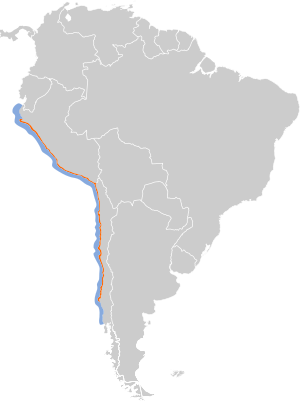Peruvian diving petrel facts for kids
Quick facts for kids Peruvian diving petrel |
|
|---|---|
 |
|
| fledgling | |
| Conservation status | |
| Scientific classification | |
| Genus: |
Pelecanoides
|
| Species: |
garnotii
|
 |
|
The Peruvian diving petrel (Pelecanoides garnotii) is a small seabird. It lives in the ocean waters near Peru and Chile. This bird is also known as the "potoyunco" in Peru. It finds its food in the cold waters of the Humboldt Current.
Contents
About the Peruvian Diving Petrel
How Scientists Named This Bird
The Peruvian diving petrel was first officially described in 1828. Two French scientists, René Lesson and Prosper Garnot, gave it the scientific name Puffinuria garnotti.
Later, this bird was placed in a group called Pelecanoides. This group was created in 1799 by another French scientist, Bernard Germain de Lacépède. The Peruvian diving petrel is a unique species. It does not have any known subspecies or different types.
What the Peruvian Diving Petrel Looks Like
The Peruvian diving petrel is a small bird. It is about 20 to 24 centimeters (8 to 9.5 inches) long. Like other diving petrels, it has a dark back and a light-colored belly. Its feet are blue. You can tell it apart from other diving petrels by looking closely at its beak and nostrils.
Peruvian Diving Petrel Behavior
What and How They Eat
The Peruvian diving petrel hunts for food in cold, open ocean waters. It dives underwater to catch small fish larvae and tiny crustaceans. These crustaceans are very small sea creatures, like tiny shrimp.
Most of its diet, about 85% to 91%, is made up of these tiny ocean organisms. The rest of its food is fish, mostly anchovies. These birds can dive very deep. They have been recorded diving up to 83 meters (272 feet) deep. However, they usually dive around 30 meters (98 feet) deep.
People once thought these birds were not very good at flying. But many Peruvian diving petrels have been seen flying far from their homes. They regularly fish about 150 to 200 kilometers (93 to 124 miles) north of their breeding areas in Peru.
Protecting the Peruvian Diving Petrel
Why Their Numbers Have Dropped
The Peruvian diving petrel used to live in many places. Now, they only nest on a few islands off the coast. Scientists estimate there are about 12,216 breeding pairs. These pairs live on San Gallán and La Vieja Islands in Peru. Some smaller groups also live on Corcovado Island in Peru. In Chile, they are found on Pan de Azucar Island, Choros islands, Grande, and Pajaros islands.
These birds lay a single egg in a burrow. They dig these burrows into guano, which is bird droppings. They can breed all year round.
Conservation Status
The Peruvian diving petrel is now considered "Near Threatened." This means their numbers are getting low. In the past, there were millions of them. However, several things caused their population to drop.
One big problem was the collection of guano. When people collected guano, it destroyed the birds' nests, eggs, and chicks. Also, workers sometimes caught the birds for food. Introduced species, like foxes and feral cats, also hunted the birds.
Even though many of their nesting sites in Peru are in protected areas, some guano collection still happens. The protected areas are the Paracas National Reserve and Guano Islands National Reserve. Sometimes, these reserves are not watched closely enough.
See also
 In Spanish: Potoyunco peruano para niños
In Spanish: Potoyunco peruano para niños


